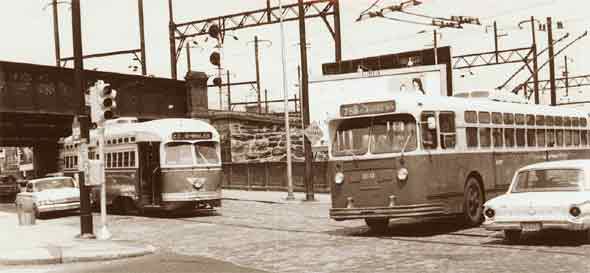|
May 2000

A Wayne Avenue trolley coach crosses in front of a
Germantown Avenue car in this 1960's view. The former
was converted as part of a pre-NCL plan, the latter survived the
abandonments.Paul Matus photo
When National City Lines
Came to
Town
Three Years That
Changed the Face of Philadelphia
Transit
by S. L. (Mac) Hackbridge
Foreword by the
Editor
For three decades spanning a worldwide depression,
World War II and an enormous postwar economic expansion, U.S. cities
were a battlefield between competing forms of transportation. By 1960 the
war was largely over and the face of America had been
changed.
What forces brought down the
street railway industry—large, well-developed and mostly free
enterprise—in so short a time span?
Forty years later the debate still rages, surprisingly hotly,
between highly polarized groups. Some hold to the argument popularly advanced
during the long years of automotive expansion and transit contraction
that railways fell of their own weight—done in by social change and
historical forces as neutral and inevitable as the rising of the sun and
the movement of the tides.
Others see a
"conspiracy" where a handful of powerful corporations set their sights on
competing business interests and executed a master plan which foresaw not
merely the end of electric traction, but of all transit, to be replaced by
private automobiles on public roads.
Both
views have currency because the answer is so complex. It wasn't a single
force, but a combination of forces taken together, that created a critical
mass which brought down a giant industry.
One
of these forces was National City Lines, formed in large part by General
Motors, Standard Oil of California and Firestone Tire, to acquire transit
systems and convert the system fleets, it is charged, to use
the founding companies' products. A major document arguing this
position was Bradford Snell's American
Ground Transport, described earlier in The Third
Rail.
It was not simply
the conversion of individual street railway systems that contributed to
the industry's precipitous decline, but the rapidity with which
conversions took place. Any industry needs a certain amount of continuing
capital investment in order to keep the suppliers of that industry afloat. In
the case of the street railway industry, this included not only
equipment builders, but suppliers of hardware, electrical equipment, track parts
and such. Rapid conversion not only ruined the market for new supplies,
but created a huge pool of spare equipment and parts which was purchased
by surviving systems, in the U.S. and abroad.
Thus the industry suppliers were deprived not only of a current market for
new materials, but a future market as well. By the time the pool of good
used equipment and parts was gone, so were the suppliers that could have
revitalized the industry.
In the case of Philadelphia, the greatest shrinkage of the
system took place in little more than three years, during
1955-1958. The following article provides some insight into how this happened.
Continued on page 2
© 2000 by The Composing Stack Inc. Not responsible for
typographical errors.
The Third Rail and The Third Rail
logo are trademarks of The Composing Stack
Inc..
|

